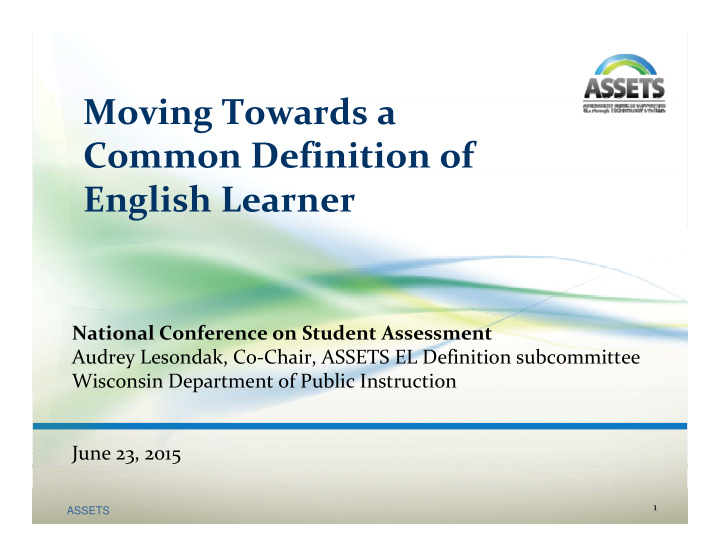



M Moving Towards a i T d Common Definition of English Learner National Conference on Student Assessment Audrey Lesondak, Co ‐ Chair, ASSETS EL Definition subcommittee Wisconsin Department of Public Instruction Wisconsin Department of Public Instruction June 23 2015 June 23, 2015 1 ASSETS
Presentation Overview WIDA/ASSETS ASSETS EL Definition subcommittee work on entry/exit protocols t / it t l Next Steps 2 ASSETS
WIDA/ASSETS • ASSETS is a federal Enhanced Assessment Grant helping the WIDA consortium fund a next helping the WIDA consortium fund a next generation English Language Proficiency test, ACCESS for ELLs 2.0. • The ASSETS consortium is separate from the WIDA h f h consortium, but largely overlapping, and consists of 35 states serving more than 1.4 million ELLs. 35 states serving more than 1.4 million ELLs. • ASSETS guided the development and operationalization of ACCESS for ELLs 2.0, scheduled to go live this winter. h d l d li hi i • The WIDA consortium will be continuing the work on EL definition that began under ASSETS on EL definition that began under ASSETS. 3 ASSETS
ASSETS EL Definition subcommittee work b itt k • Conducted literature reviews and surveyed WIDA states states • Worked to find common ground between local control and state control, urban, suburban, and rural schools • Investigated common EL entry and exit criteria and state laws Investigated common EL entry and exit criteria and state laws and created a crosswalk across PLDs • Identified EL entry and exit as critical processes in defining EL g • Recognized the complexity of the schools, districts and families served • Began work to better understand the national g landscape on EL entry • Clearly identified need for consistent protocol for ELL entry and exit. • Surveyed OCR/USED home language survey (HLS) questions, other WIDA states’ HLSs 4 ASSETS
Sample HLS Question Discussions OCR/USED ‘languages used in the home’ If L2 is being learned in school and practiced at home, should we be screening? h ld b i ? Can we ask this in another way to determine if family members using another language are meaningfully engaging with the student? engaging with the student? Does it matter who in the home is using it? What about outside of the home in a child ‐ care setting? OCR/USED ‘first language learned’ If not English, is the student still using this language? If so, with whom, and how often? , , ‘What language does this student most often use with siblings?’ For many students likely unnecessary For adopted For many students, likely unnecessary. For adopted siblings, possibly critical reinforcement of L1. 5 ASSETS
Re ‐ envisioning ELL Entry Organized HLS and LIS questions into a two tiered Language Use Inquiry (LUI) two ‐ tiered Language Use Inquiry (LUI), designed to only ask more specific questions when necessary questions when necessary Identified common ways existing HLS questions tend to produce incorrect decisions to tend to produce incorrect decisions to screen/not screen and worked to add additional safeguards to prevent this safeguards to prevent this Core language suggested by OCR, but additional nuance available if needed 6 ASSETS
7 ASSETS
LUI Testing g Held Cognitive labs with 100+ educators to gather data on the usability and reliability of the LUI data on the usability and reliability of the LUI 20% worked in low ‐ incident ELL schools (< 1% ELL) 25% worked in fairly high ‐ incident schools (> 20% ELL) 25% worked in fairly high incident schools (> 20% ELL) Mix of rural, suburban, and urban schools, in several states Educators read student profiles and then assessed the mock students using the LUI ~85% agreement on whether or not to screen when using the LUI instrument (Significant for situations where language dominance is less clear.) Data ‐ informed improvements to LUI 8 ASSETS
Sample Student Profile Lamin Ousman was born and grew up in The Gambia, where he went to school from age 4 to age 12. There, school is taught went to school from age 4 to age 12. There, school is taught entirely in English. Lamin speaks and understands English, Mandingo and some Wolof. At the age of 13, he came to the United States to live with his aunt and uncle. He’s now enrolled at their local public middle school. at their local public middle school When with his aunt and Uncle, Lamin speaks English, because his aunt doesn’t speak any other languages However Lamin aunt doesn t speak any other languages. However, Lamin attends some family events with his uncle, where Mandingo and Wolof are spoken along with English. Lamin has also been learning Arabic on the weekends as part of his religious studies. 9 ASSETS
Paper LUI Example 10 ASSETS
Online LUI Example 11 ASSETS
Online LUI Example 12 ASSETS
LUI Future Data from cog ‐ labs allowed the identification and improvement of identification and improvement of ambiguously worded questions a lack of default choices if a question is l k f d f l h i if i i unanswerable better flexibility for truly bilingual students b tt fl ibilit f t l bili l t d t the necessity of identifying and providing state/district specific guidance on previously state/district ‐ specific guidance on previously identified ELLs 13 ASSETS
EL Definition Future Work ELL Entry LUI Pilot Refinement of instrument Supplemental documentation, operationalization pp p ELL Exit Survey new academic standards and content assessment scores. ‘What does proficient mean?’ p Consider ACCESS for ELLs 2.0 standard ‐ setting Explore minimal or base ‐ line ELP assessment results options as part of exit protocol Documentation and guidance on exiting to allow consortium states to move closer to a standard exit criteria 14 ASSETS
Contact Information ASSETS Grant Coordinator Jesse Roberts: jesse.roberts@dpi.wi.gov ASSETS EL Definition Subcommittee Chairs Jonathan Gibson: jgibson@doe.nv.gov A d Audrey Lesondak: audrey.lesondak@dpi.wi.gov d k d l d k d i i 15 ASSETS
Recommend
More recommend